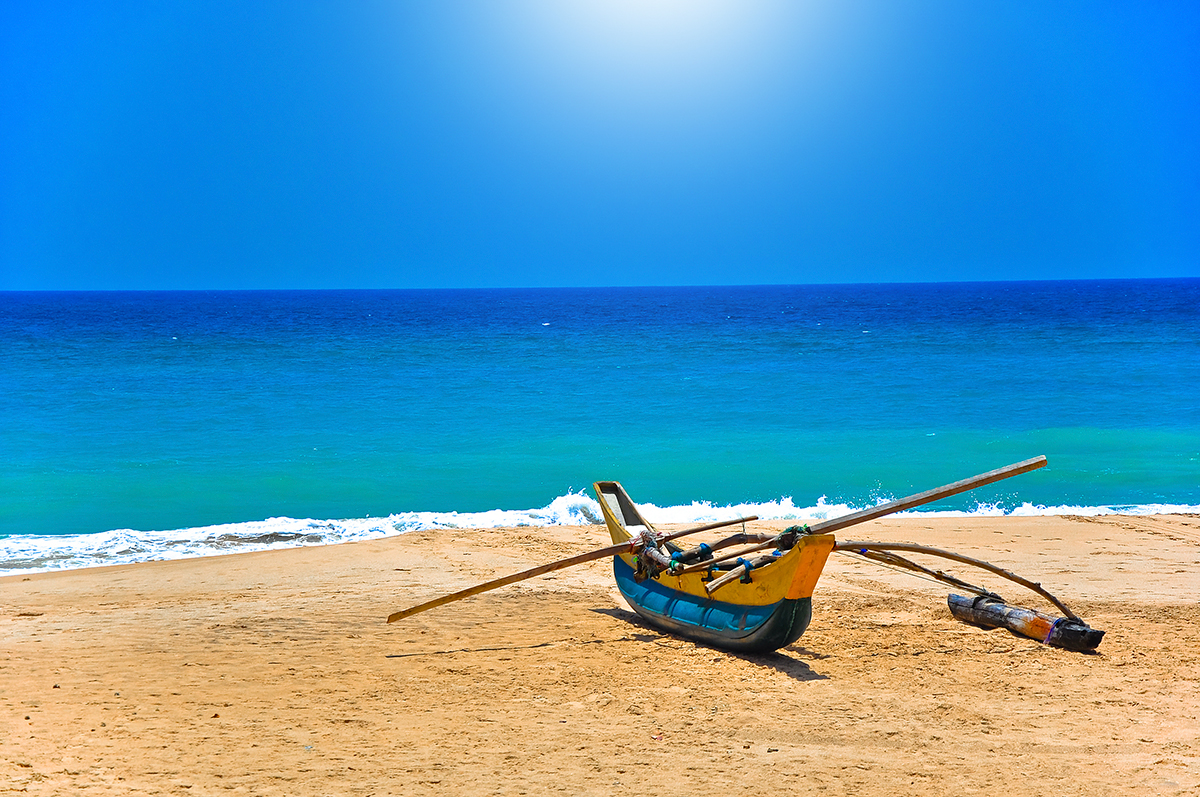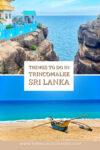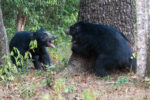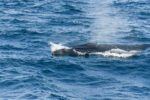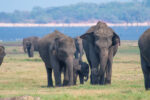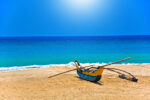Lying on the east coast of Sri Lanka, 257 km northeast of Colombo, Trincomalee is considered to be one of the finest natural deep-water harbours in the world. It is second in size only to Sydney Harbour in Australia.
Trincomalee is home to some fine beaches, including Nilaveli, Uppuveli and the off-shore Pigeon Island – a popular diving and snorkelling destination. It is also one of the best whale-watching destinations in Sri Lanka, after Mirissa, and home to the most photographed temple on the island – Pathirakali Amman Hindu Temple.
We visited Trincomalee as part of our Sri Lankan safari, and while my friends spent a couple of days diving, I explored the town and its surroundings. As a purely terrestrial person, I never took to diving. Thankfully, there are plenty of things to do in Trincomalee apart from diving.
Pathirakali Amman Hindu Temple
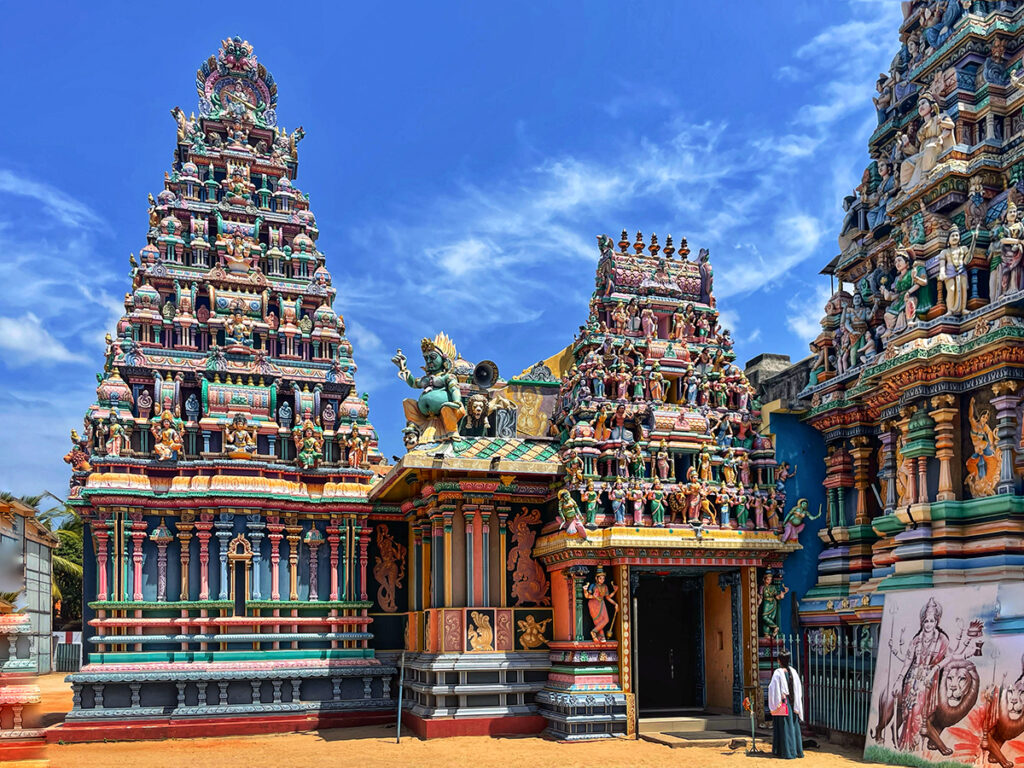
Pathirakali Temple, located not far from the fort is quite possibly the most colourful temple in Sri Lanka. Its facade is decorated in a typical Hindu style, but the interior of the temple is an explosion of colour and ornaments.
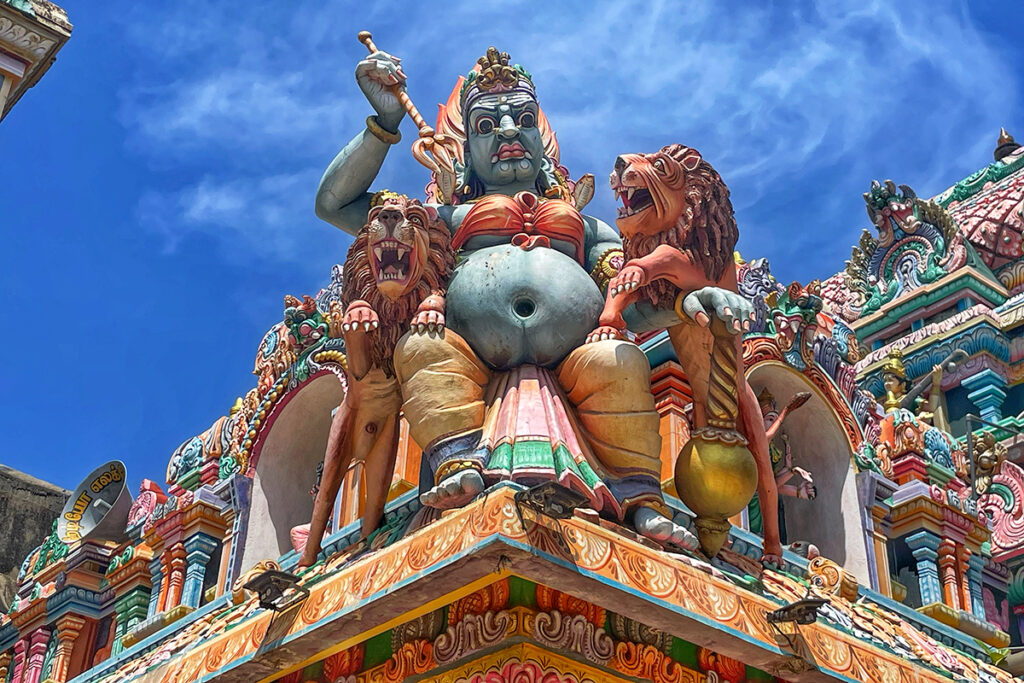
Being the temple of goddess Kali, or Badrakali to be precise, the ancient temple is decorated with a vibrant mix of animal figures. There are lions, horses, and dragons supporting the pillars, cobras lining the edge of the ceiling, and crocodiles, octopuses, elephants, giant geese and cows looking down from the ceiling.
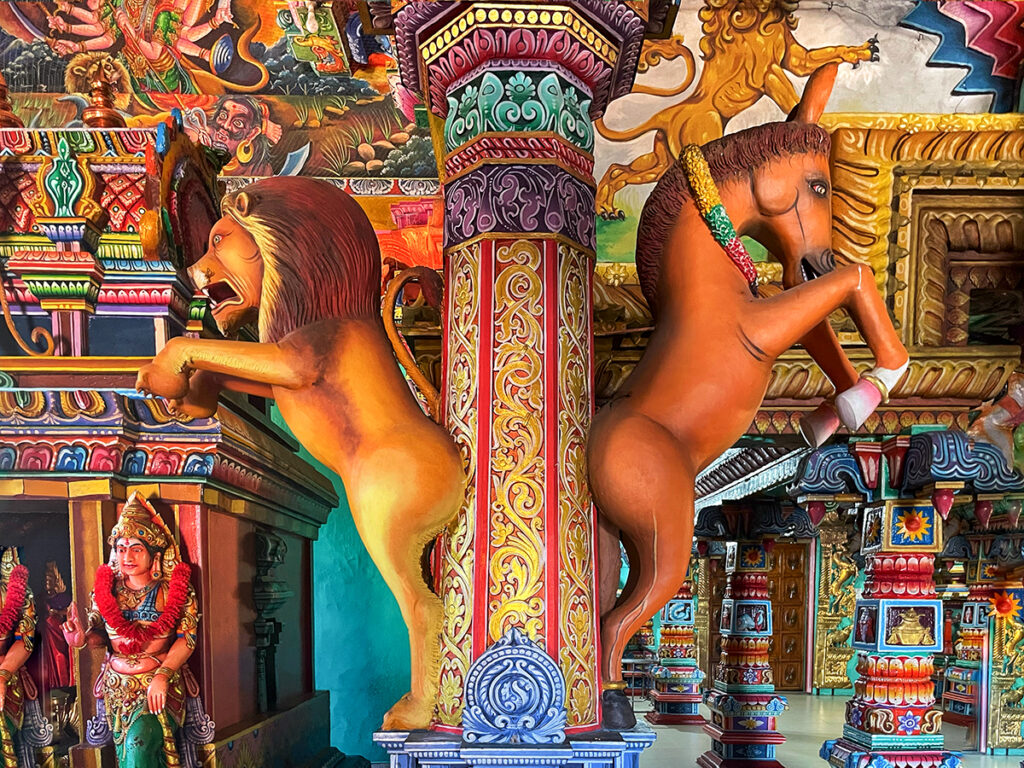
Every ornament is painted in a different bright colour. At first glance, when you see everything at once, the interior of the temple looks like an amusement park. You don’t know where to look. But as you explore the different creatures depicted in the decorations you’ll be amazed by the detail and diversity. It is certainly the most striking temple in Trincomalee.
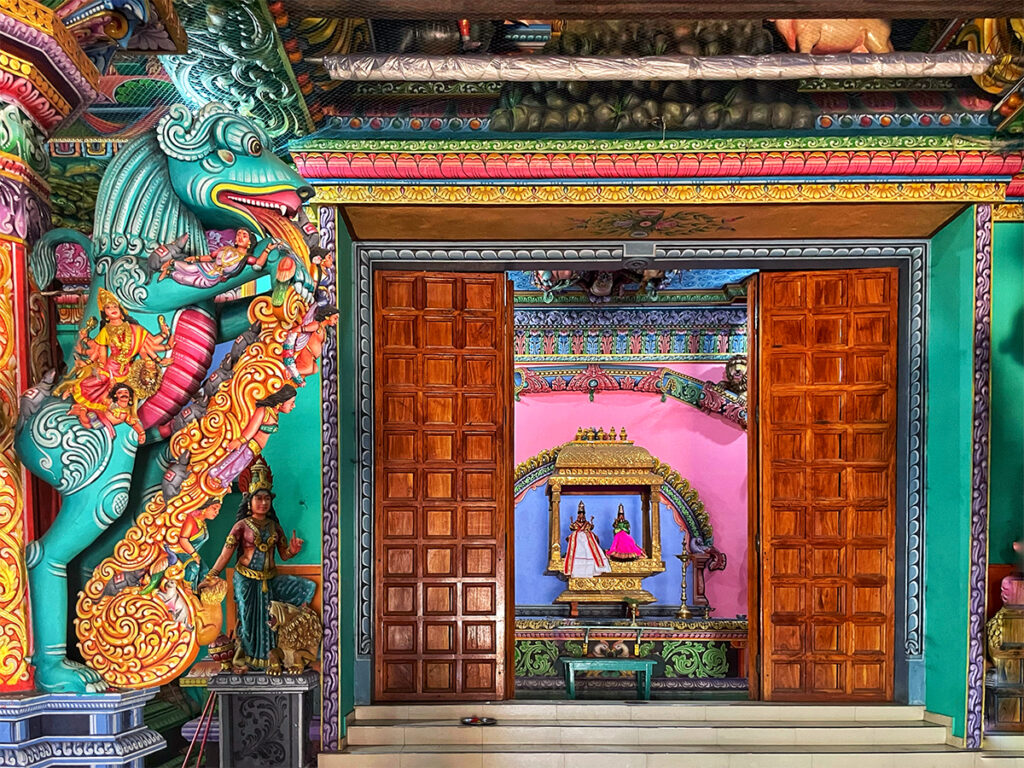
So if you are looking for things to do in Trincomalee, make sure to add Pathirakali Amman temple to your itinerary. You can easily visit Pathirakali Amman and Konrswaram temples and Fort Frederick at the same time – they are located within walking distance of each other.
Whale watching
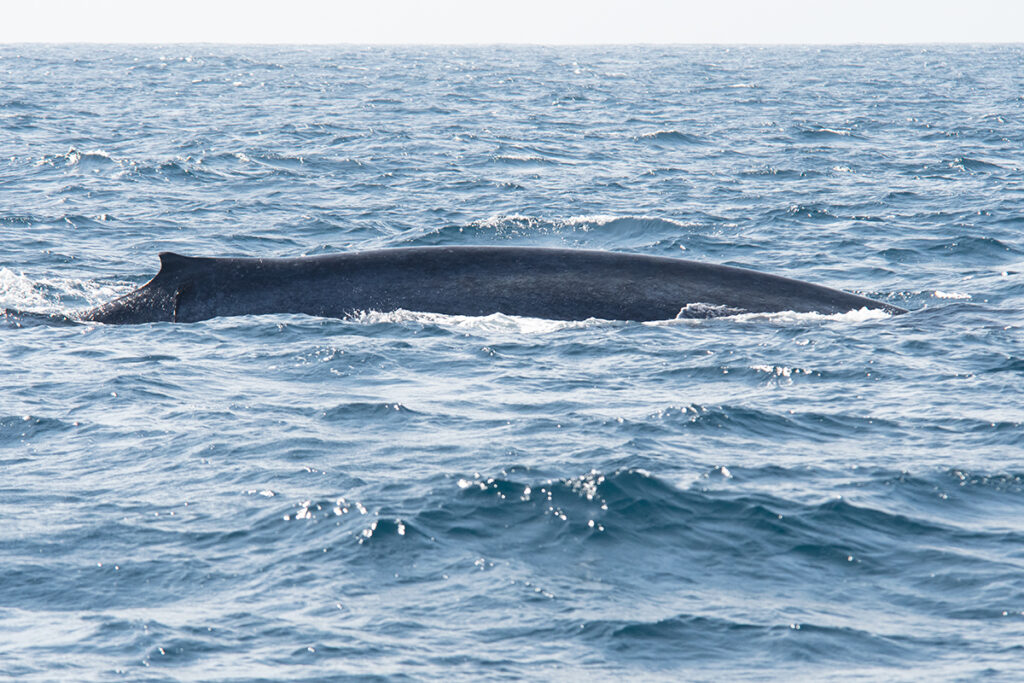
In Trincomalee, whale watching season is from July to September. So if you are in town during these months, you have a chance to see the incredible Blue Whales – the largest living animals on earth.
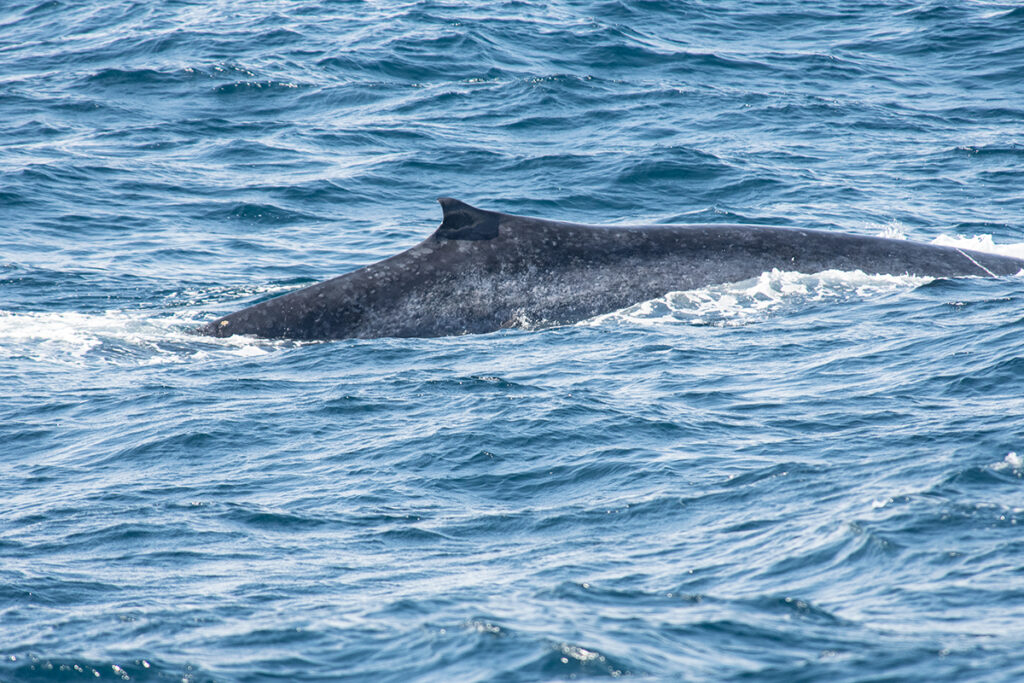
The waters of the Indian Ocean off Trincomalee are also home to several other species of whales, including Sperm whales and Bryde’s whales, as well as Spinner and Bottlenose dolphins. The chances of spotting a whale are about 50%.
But even if you are not lucky enough to see a whale, you will almost certainly see the dolphins. And Spinner dolphins are really fun to watch, especially if they come to ride the bow wave of your boat.
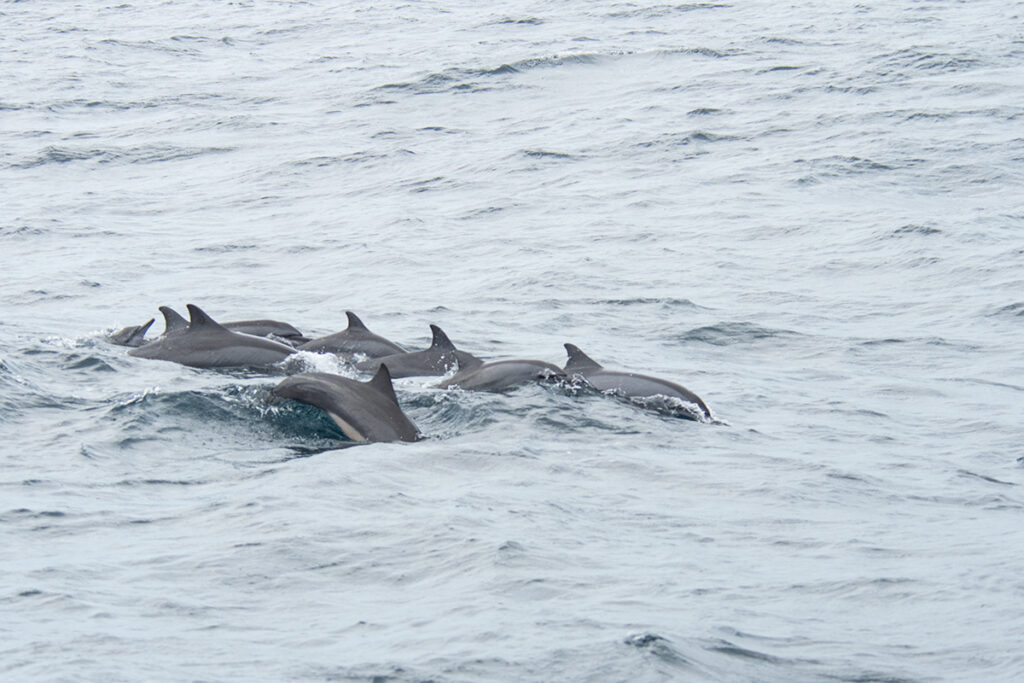
One thing to keep in mind is that Whale watching tours depart at 6 am. Early in the morning, the sea is at its calmest. And it matters a great deal – the Indian Ocean is not a calm ocean. So if you are prone to seasickness, make sure to take the sea sickness tablets 1-2 hrs or so before the trip. You can buy them at most pharmacies in Trincomalee.
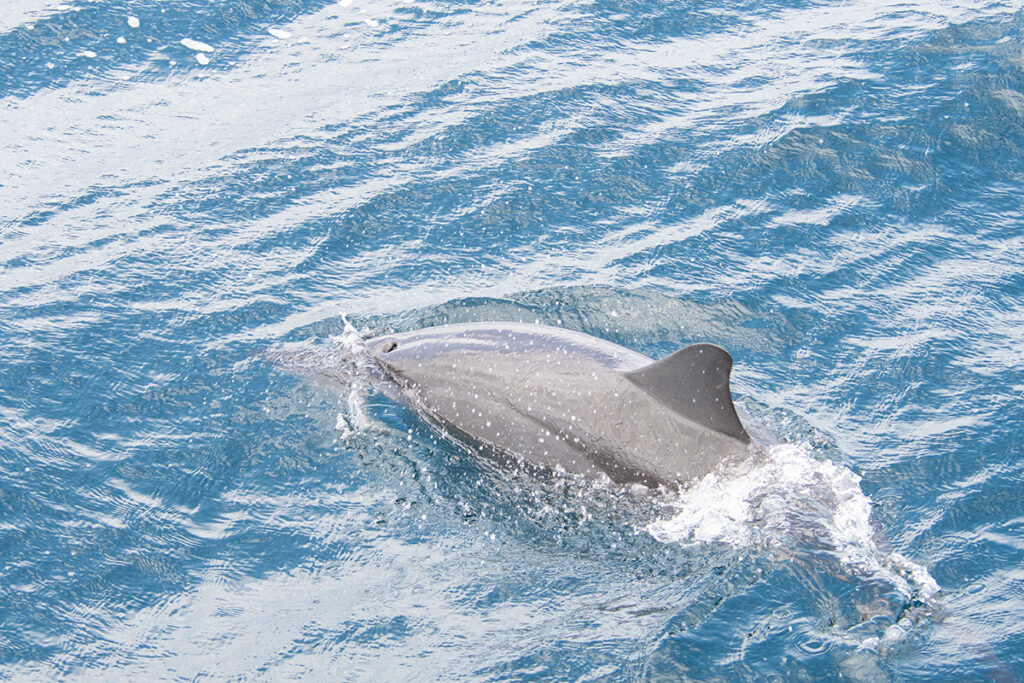
An average whale-watching tour lasts about 3-4 hours and costs around 100 AUD. You can pre-book your whale-watching tour in advance.
Tip: If you are visiting Sri Lanka during the eastern monsoon (November to March), you can see whales in the south of the island – in Mirissa. Sri Lanka has two distinct monsoon seasons, and when it is raining in the east, it is perfectly sunny in the south.
Snorkelling at Pigeon Island
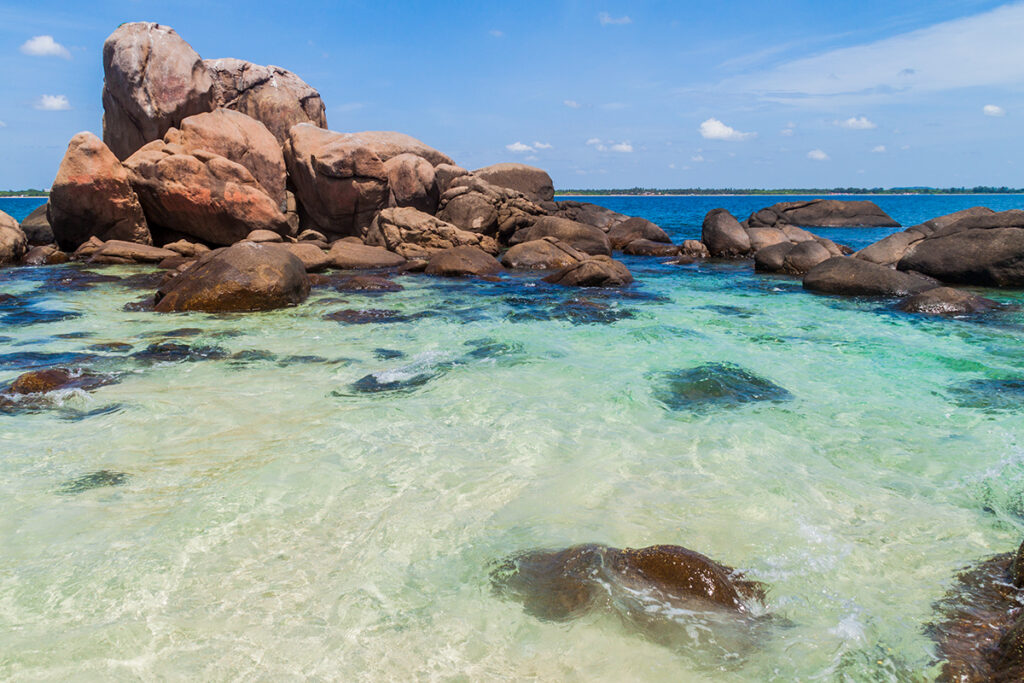
Pigeon Island National Park is an idyllic island just off Niavelli Beach. It is surrounded by coral, which makes it a popular diving and snorkelling spot.
There are a couple of things to consider before committing to a trip to Pigeon Island. First, it is expensive. As with all national parks in Sri Lanka, visiting Pigeon Island will set you back $30. Thankfully, most other places around Trincomalee are free to visit, so a single $30 attraction won’t break the budget. It is a different story around Sigiriya where almost anywhere you go, you have to fork out $30 entrance fee.
The other concern with Pigeon Island is that it has suffered from over-tourism, and much of the reef has been damaged. So don’t expect the pristine coral you may have seen in other parts of Asia. Having said that, the island is undoubtedly beautiful, and you do get to see green turtles, lots of colourful reef fishes and aquatic invertebrates and, if you are lucky, Black Tip reef sharks.
Most accommodation providers in Trincomalee will be able to organize a trip to Pigeon Island. Alternatively, you can pre-book your Pigeon Island snorkelling tour in advance.
Snorkelling at Coral Island
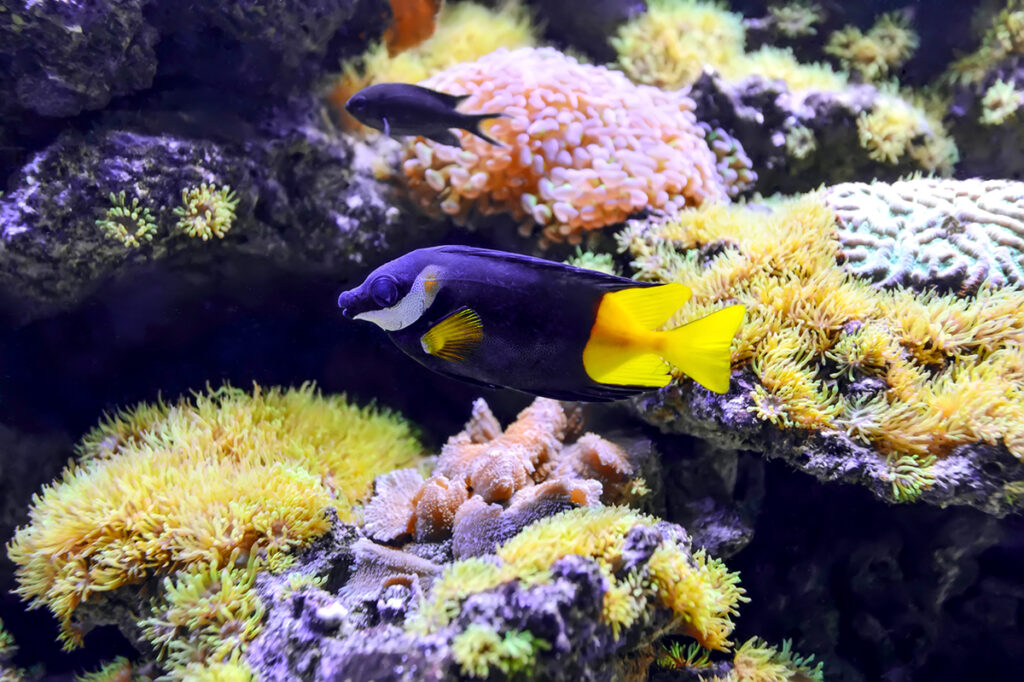
If you’d rather avoid the hordes of tourists on Pigeon Island, consider a trip to Coral Island instead. It lies a few kilometres north along the coast from Nilaveli and has some very well-preserved living coral, including cabbage coral. The snorkelling tours depart from Trincomalee around 8 am (for the best underwater visibility), and the boat to Coral Island takes about 20 minutes.
You will see similar marine life at Coral Island as you would at Pigeon Island apart from the Black Tip sharks. You can pre-book the Coral Island tour in advance as well.
Fort Frederick
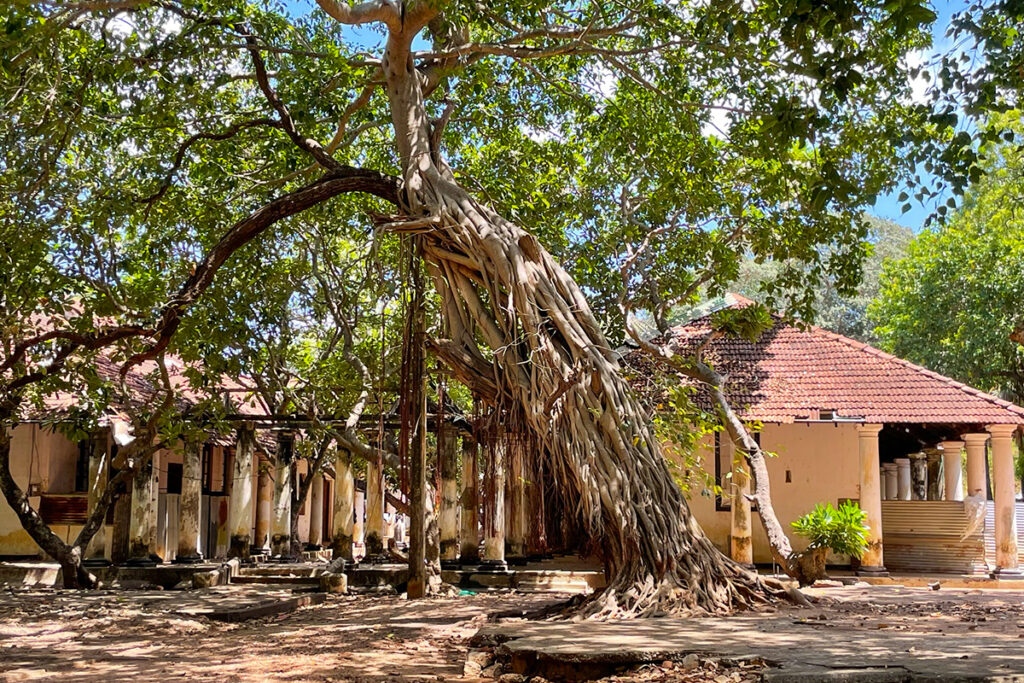
For European culture buffs, wandering around Fort Frederick is the most popular thing to do in Trincomalee. Standing on top of the Swami Rock, Fort Frederick was built by the Portuguese in 1624 mainly from the debris of the legendary ancient Hindu Konrswaram Temple that stood at the site.
The destruction of the temple is considered the biggest loot of one of the richest temples in Asia. The recently restored temple stands a little further away now.
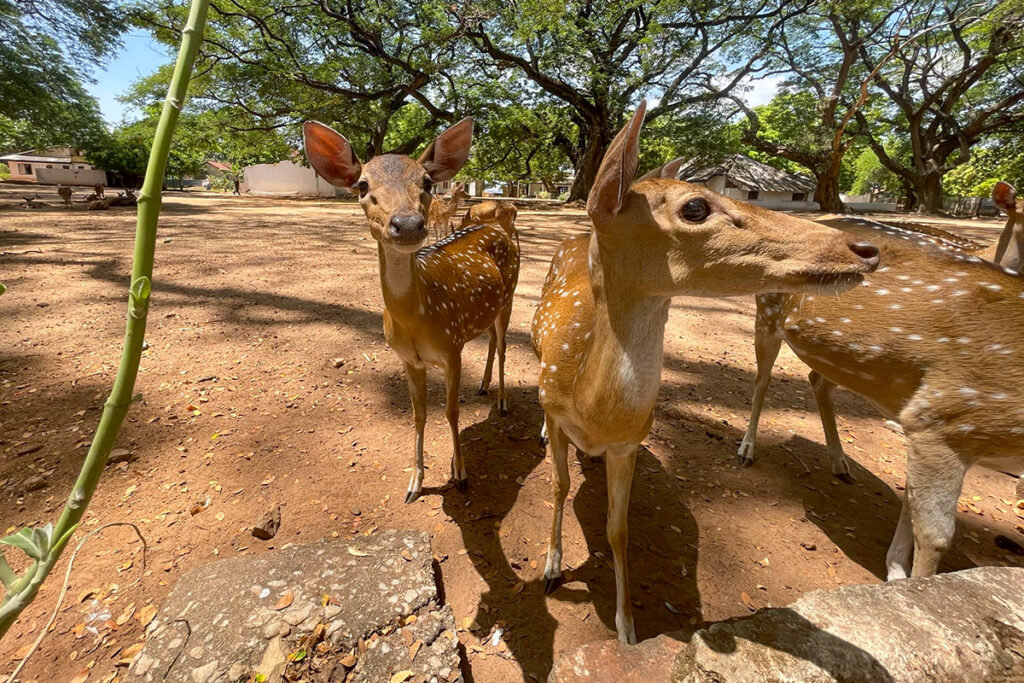
The fort has seen several battles in the 17th century and there are several battlements remaining today. Unless you are a huge fan of military history, one of the best things about visiting the fort is that it’s shaded. The main road through the fort runs under the interlocking crowns of giant trees, either planted or preserved by the Portuguese.
There are several structures along the main road where you can see the columns sacked from Konrswaram Temple. There isn’t too much of the fort left beyond its impressive gate, a few crumbling buildings, and gun points, but there are plenty of very tame spotted deer wandering the grounds.
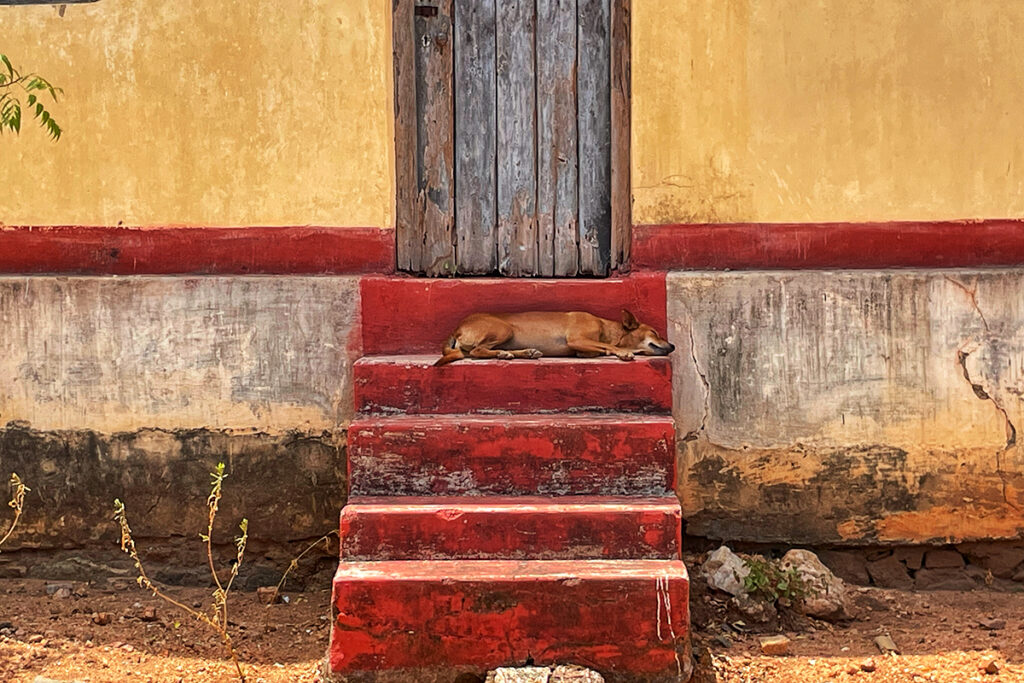
It’s a pleasant area to walk through if you can look past the fact that the buildings around you were built from vandalized ancient blocks and columns.
Konrswaram Temple
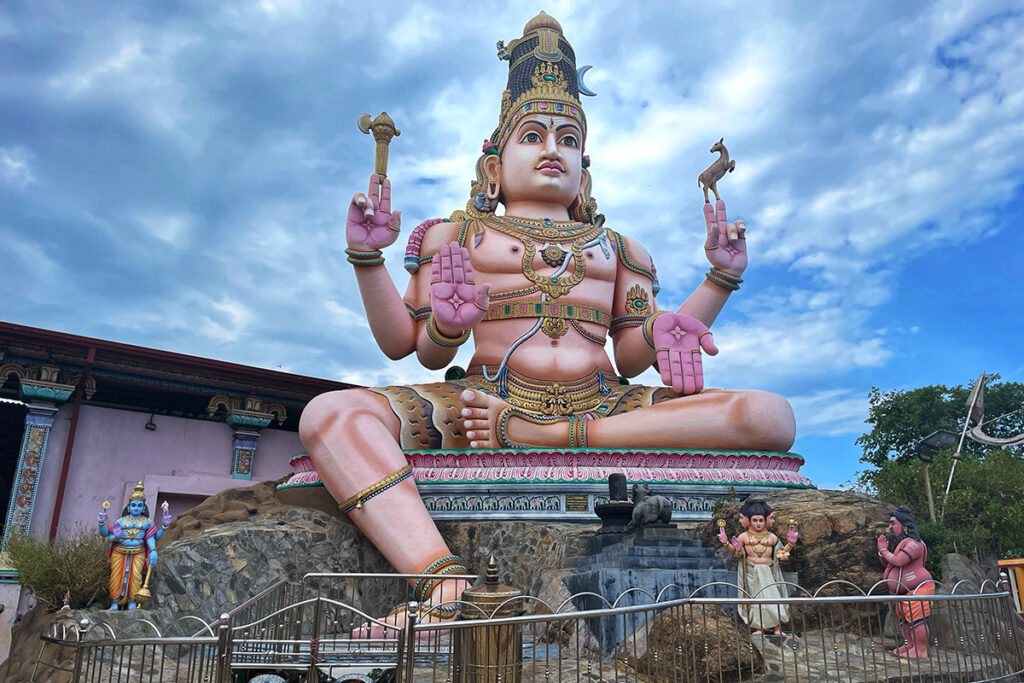
At the end of the walk through the fort, you come to a street lined with souvenier shops that leads to Konrswaram Temple. Trincomalee’s most famous temple is a distant echo of the original structure. The name Konrswaram means a thousand pillars and refers to the thousand pillars hall of the original temple.
The original complex was destroyed by the Portuguese. As the story goes, Portuguese soldiers entered the temple dressed as priests and began looting it and throwing statues and structures off the cliff into the sea below. The priests managed to save a few of the temple’s structures as they fled and buried them in the surrounding area.
Having destroyed the ancient structure, the Portuguese used the rubble and the remaining pillars to construct Fort Frederick. The temple was only restored in the 1950s, so it’s quite a new building.
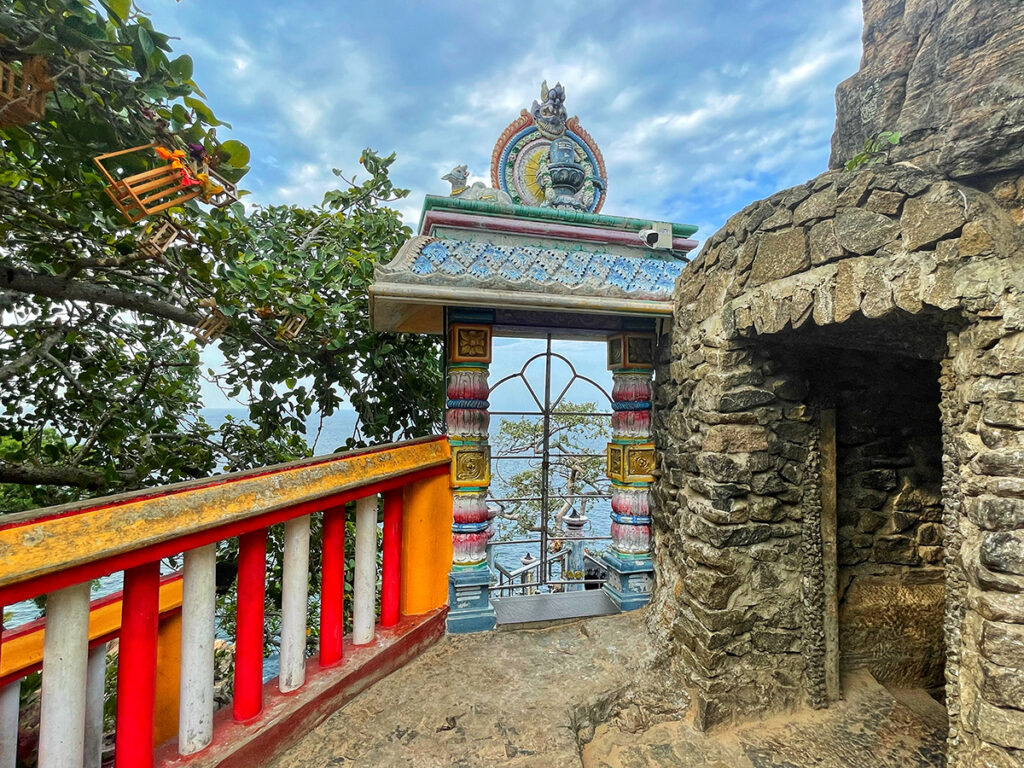
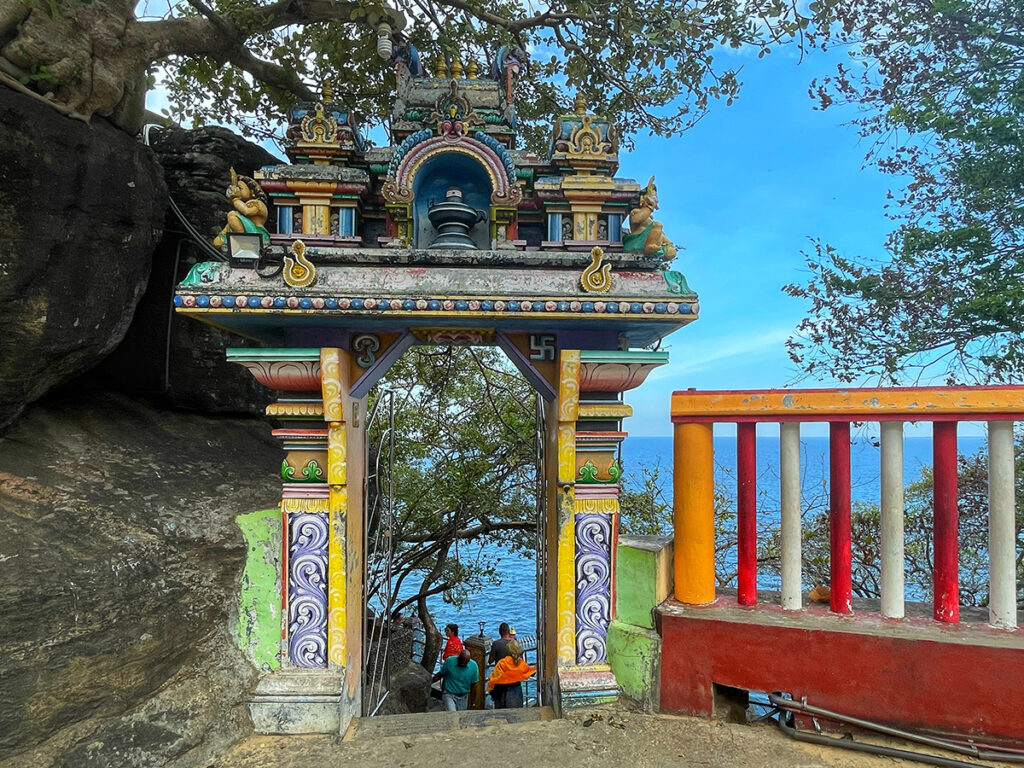
There is a lovely walkway along the edge of the cliff with some statues tucked into the nooks and crannies on the cliff wall. And the ocean views are absolutely beautiful.
One word of advice – avoid visiting the temple in the middle of the day – if you don’t want to fry your feet. As with all temples in Sri Lanka, you’ll have to leave your shoes outside (in the designated area) and the ground around the temple gets scorching hot by about 11 am unless you are visiting on an overcast day.
Lovers Leap
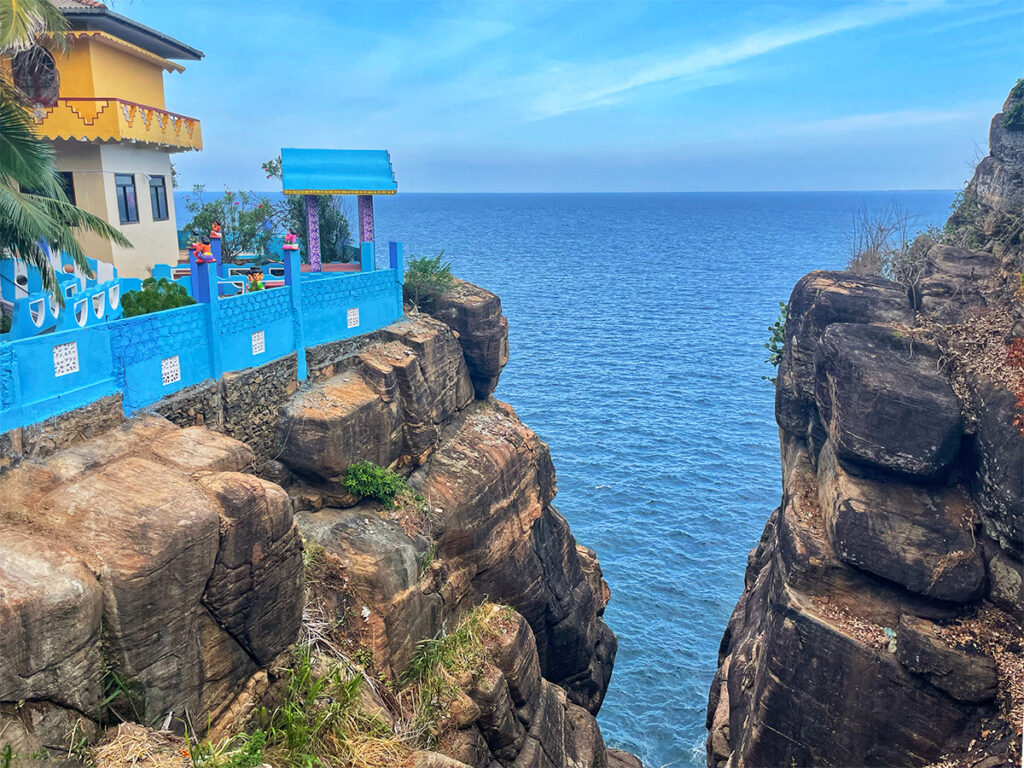
When you are finished at the temple, before you leave the grounds don’t miss the lookout over the cliff wall. Known as Lovers Leap, it is not signposted and is easy to miss. There is a low stone fence between the temple grounds and the road with all the souvenir shops. If you are looking at the temple, it is on your right, before the giant statue.
From this lookout, you see a dramatic split in the cliff with a temple building on one side and some other structure on the other. Hence the name – Lover’s Leap.
Fresh Juice with a view
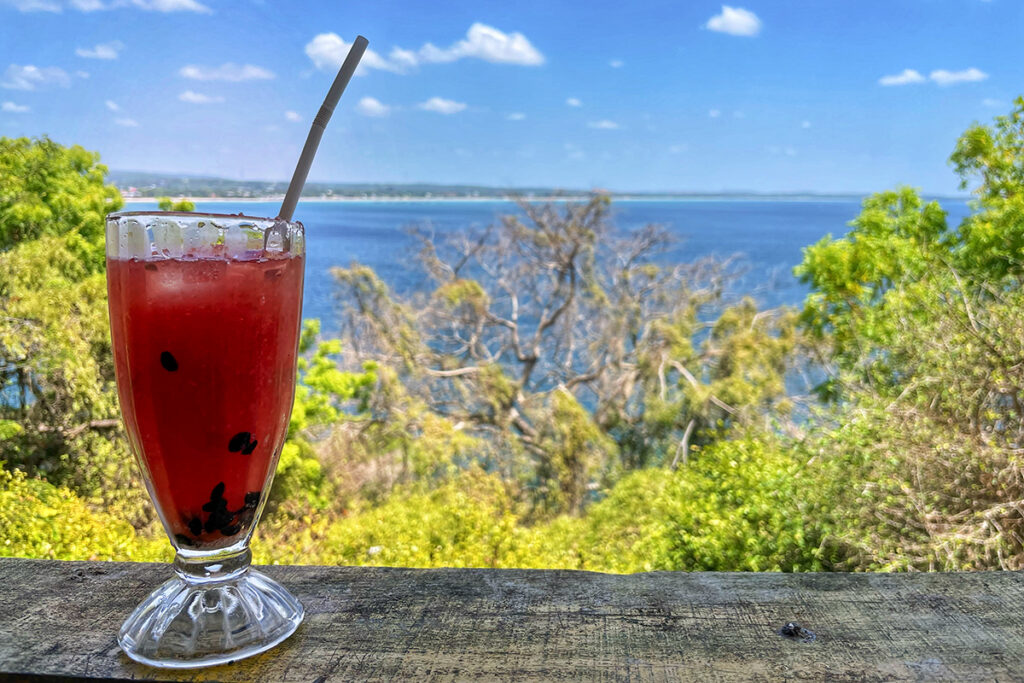
As you leave the temple, you will no doubt be hot and parched. Luckily, among all the souvenir shops that line the road to the temple, there are several juice bars selling freshly squeezed juices.
Pick a bar with a sitting area at the back, and it will have a fantastic view of the ocean and the Trincomalee coastline. Order a cold, freshly squeezed juice and cool off, enjoying the view. You might even find some grey langurs or spotted deer on the rocks just below you. The juices cost between 600 and 700 rupees.
Trincomalee & Uppovali Beaches
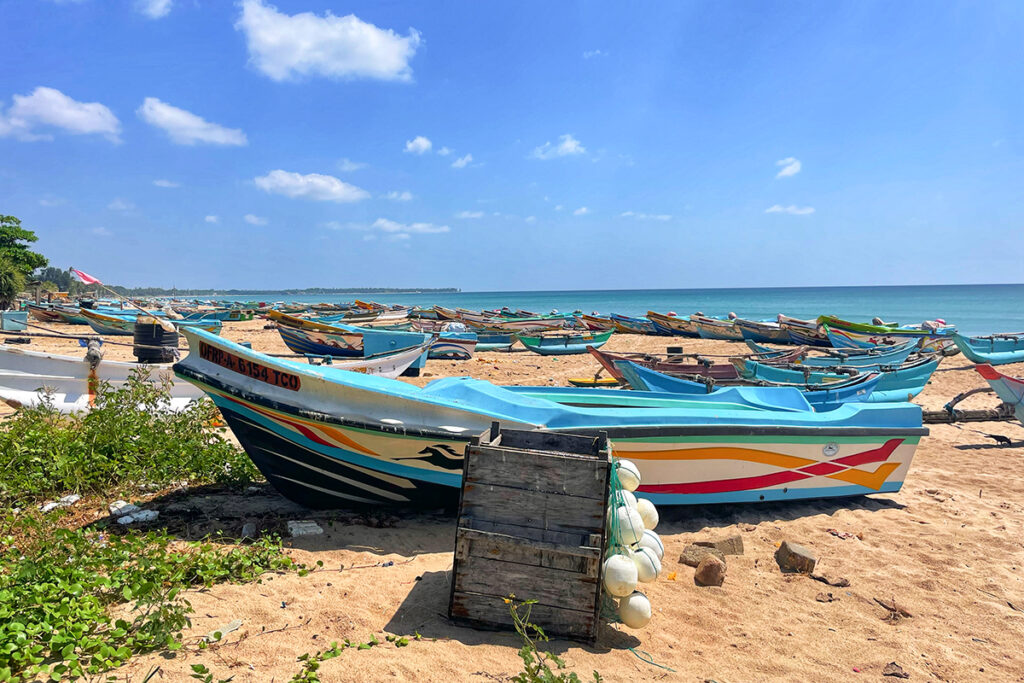
Of all the things to do in Trincomalee, beach hopping is one of the most popular. The northern side of Trincomalee is essentially a 30-km-long stretch of sand made up of several beaches. One of these beaches is the Trincomalee town beach. It has a gentle surf, perfect for swimming, and the beach is studded with colourful fishing boats.
Uppovali Beach starts where Trincomalee Beach ends, although there are no physical boundaries between the two. Uppovali is the livelier of the two and perhaps a little prettier.
Niaveli Brach
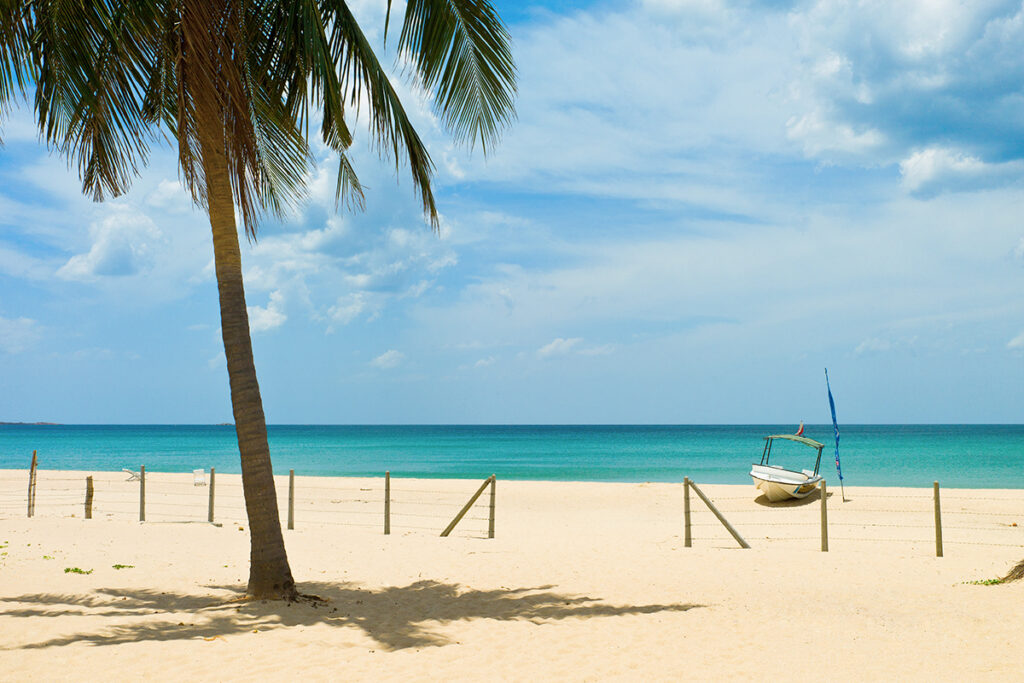
Further north is Nilaveli Beach, the prettiest of the three. Nilaveli is advertised as Sri Lanka’s answer to the Maldives. This white sand beach is composed of powdery white coral sand. East coast beaches are generally much calmer than those in the south, and at Nilaveli, in particular, you can wade in the water up to your waist level for hundreds of meters.
Nilaveli is the departure point for Pigeon Island boats, so if you are heading to the island, you’ll get to experience Niaveli as well.
Marble Beach
If you are a true beach connoisseur, you might have heard about Marble Beach in Trincomalee, which is considered to be one of the most beautiful beaches on the east coast of Sri Lanka. Lying 18 km out of Trincomalee, it takes a bit more effort to get to.
If you do some research online, you’ll find Marble Beach described as tranquil, blissful, and virtually unknown. In reality, Marble Beach is packed. It is one of the most crowded beaches I have seen in Sri Lanka. It may well be tranquil and deserted at 7 am, but during the day, it is anything but.
We did a drive-by around midday on our way out of town, and once we saw the crowds, we decided against visiting it. If you have visited Nilaveli Beach, there is no reason to go to Marble Beach.
Sri Lankan Mosques
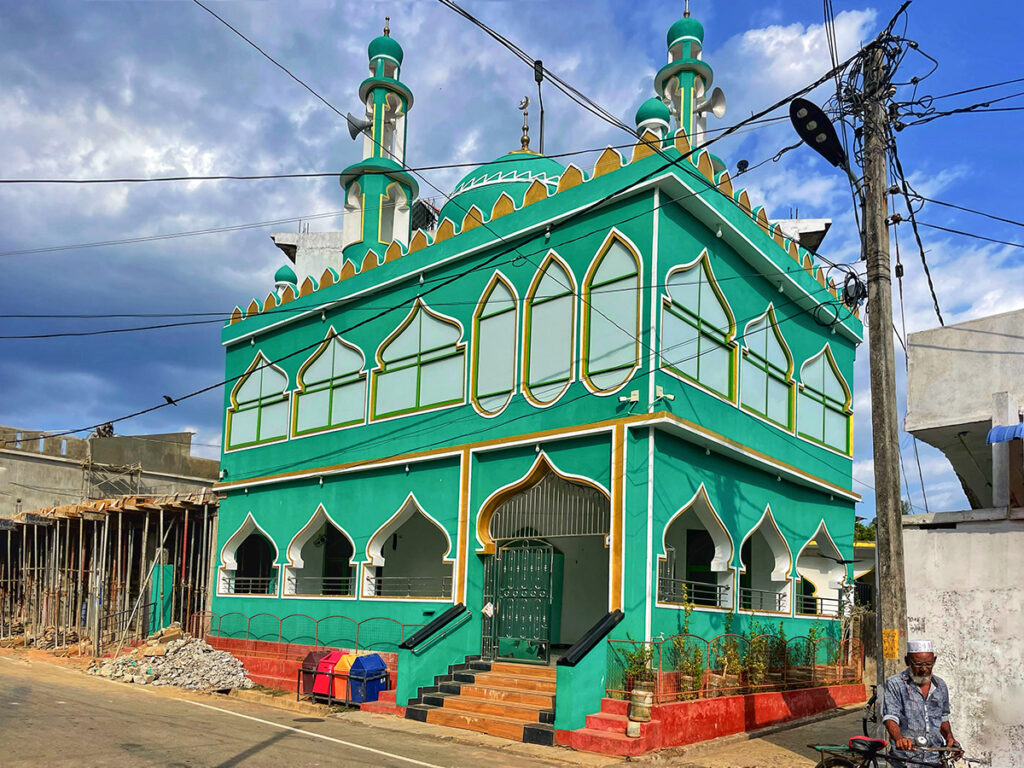
Trincomalee is one of the most religiously diverse places I’ve seen. There are Hindu temples, Buddhist temples, Christian churches and some very cute Mosques. You can attend a Buddhist festival and hear Muezzin’s call to prayer while you are there. It’s quite incredible. The only other place like this I visited was Langmusi town on the Tibetan Plateau.
While Hindu temples in Trincomalee are quite grand, the town’s mosques are cute green structures that stand out against surrounding buildings like bright gems. There are several mosques in town. The one I liked is Jummah Mosque just off North Coast Road.
The mosques are not tourist places, but you don’t need to go inside to appreciate the ornate and colourful buildings.
Ruined Temple
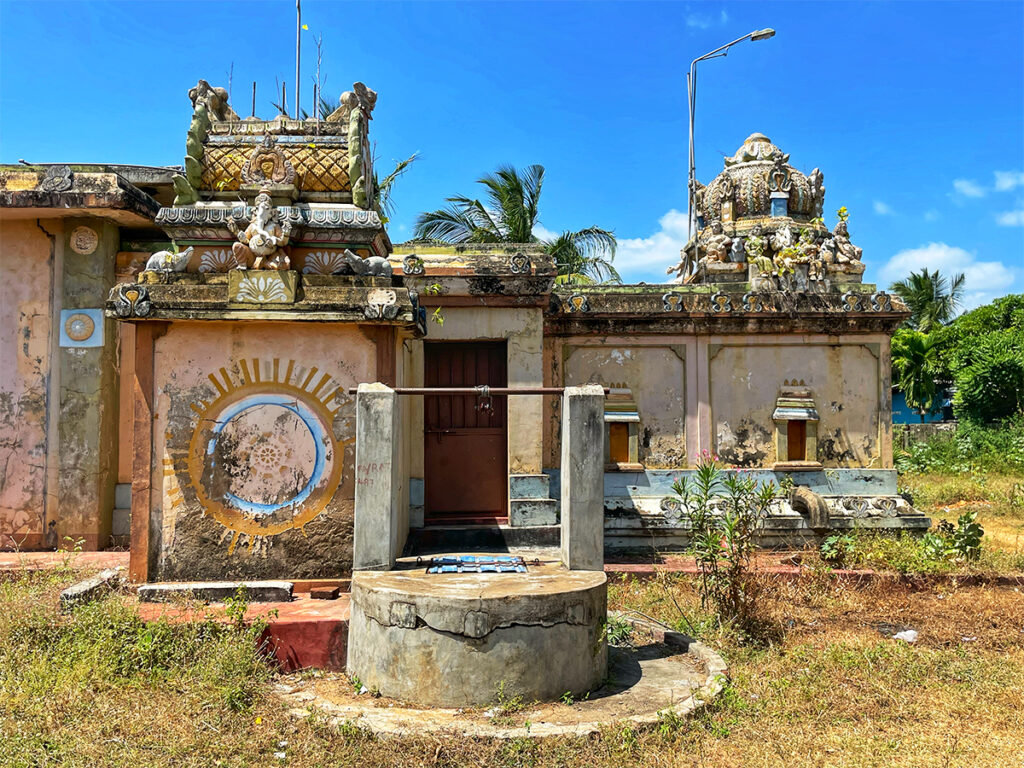
Not far from the Jummah mosque, also on North Coast road, there is a crumbling old Hindu temple. It’s not marked on Google Maps, and it seems to be abandoned, so I don’t know what it is called, but it’s an interesting structure next to Modern Learners Driving School. It has that ruined temple vibe that makes me think of Indiana Jones movies.
The main gates may be shut but you can enter the site through a smaller gate next to it. There isn’t much to see beyond the main building, so it’ll be a quick visit.
Day Trips from Trincomalee
If you have more time in Trincomalee, consider taking a day trip to some nearby historic sites and national parks.
Anuradhapura
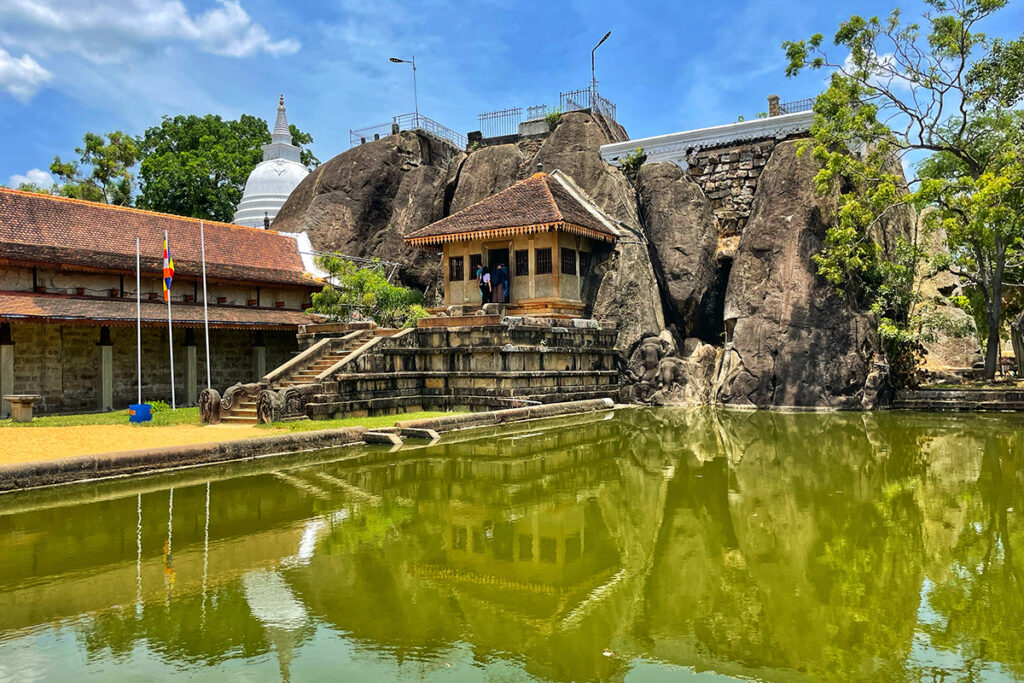
In the north is the ancient city of Anuradhapura – a UNESCO World Heritage Site, Sri Lanka’s first capital and Royal city founded in 437 BC. The city began as a small town established by an exiled South Indian prince but was later expanded to become the capital city of the Anuradhapura Kingdom, which ruled the entire island for almost 1500 years.
The archaeological site of the sacred city is quite spread out, so unless you have your own car like we did, you’ll need to hire a tuk-tuk or book an organized tour.
Like most important attractions in Sri Lanka, the ancient city complex attracts a steep entree fee of $30. However, there are several sites you can visit for free or for a much smaller fee. Watch this space for my guide to the free (and almost free) sites at Anuradhapura. If you don’t have your own set of wheels, you can book an organized tour to Anuradhapura from Trincomalee as well.
Sigiriya
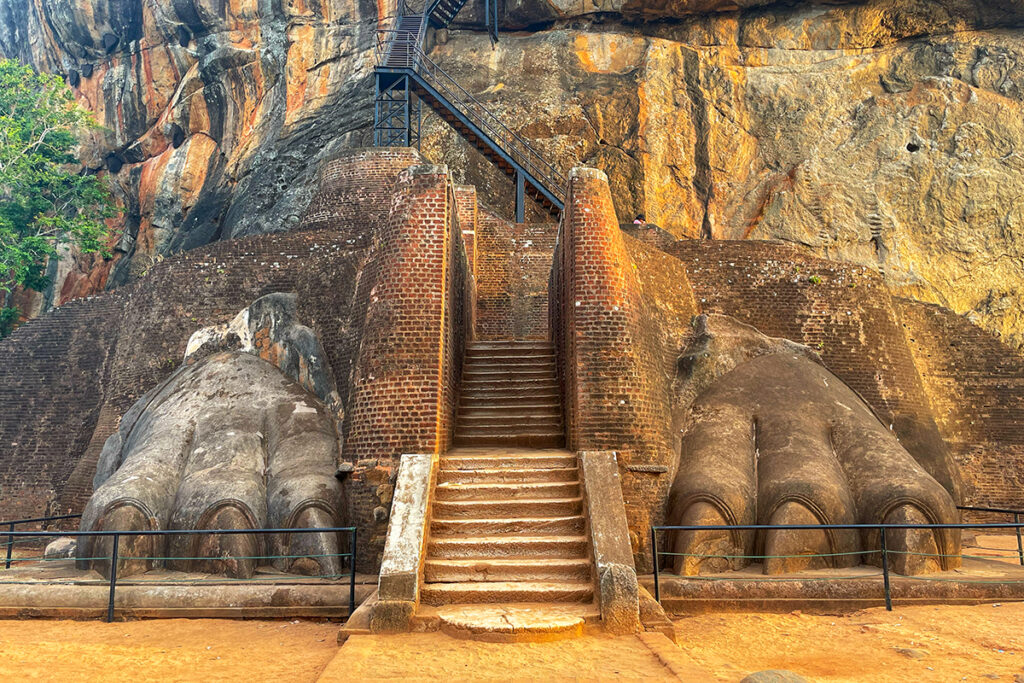
Sigiriya Rock is a spectacular sight also listed with UNESCO World Heritage. It is a 180-meter-tall rock, the vent of an ancient volcano, with a Royal citadel on its summit. The reason for such an unusual location for the Royal palace is that King Kassapa I (477–95), an illegitimate son of an Anuradhapura king, murdered his father, ran to Sigiriya and declared himself king.
So to avoid a similar fate at the hands of his brother, the true heir to the throne, he established his citadel at the most unassailable location.
Climbing Sigiriya rock in Sri Lankan heat is hard work, but a rewarding experience. Watch this space for my detailed guide. For a hustle-free experience, you can book a day tour from Trincomalee to Sigiriya that includes a visit to Dambulla Caves.
Minneriya or Kaudulla National Park
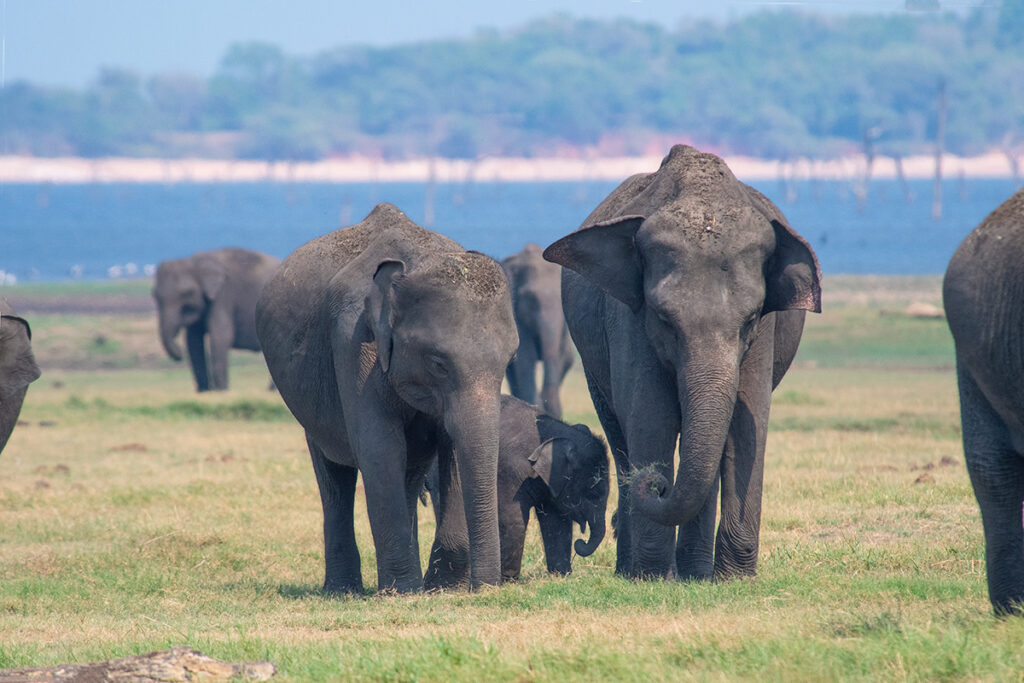
This one is for wildlife lovers. If you are visiting around August-September, you have an opportunity to witness a unique wildlife spectacle – the Great Elephant Gathering. By the end of the dry season, all water sources in central Sri Lanka dry out and elephants travel from far and wide to the permanent water reservoirs in Minneriya and Kaudulla National Parks.
It is a dangerous time for the elephants since they have to travel through human-dominated landscape to get to the water and many get shot and injured in the process. We came across an elephant on the highway not far from Minneriya National Park, and the local drivers had virtually no patience for the animal. They waited for no more than a minute before driving around the elephant to continue on their way. If you are driving at this time of year, please stop and give the animals some space to cross the road.
If you’d like to see hundreds of elephants gathering around the water reservoirs, check with the tour operator which park the gathering is currently at – it will be either Minneriya or Kaudulla. As with all national parks in Sri Lanka, you can only visit on an organized tour with a jeep and a driver. If you are a planner, you can pre-book your Elephant tour in advance.
You can see elephants in either Minneriya or Kaudulla at any time of the year, there just won’t be as many as during the Great Gathering.
Wilpattu Safari
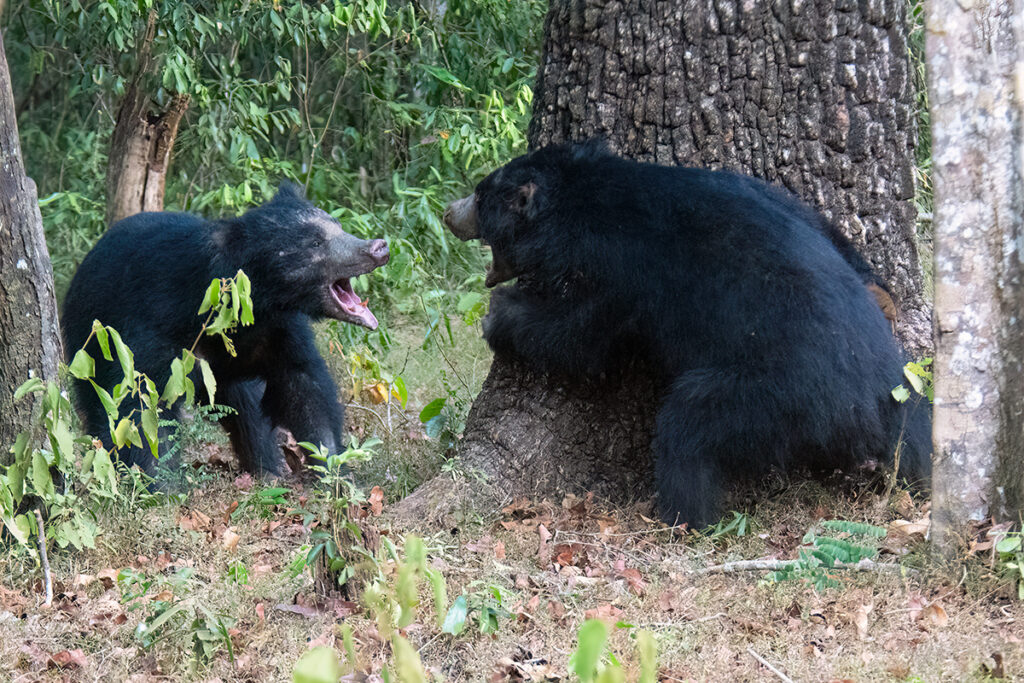
Another safari you can take from Trincomalee is a tour to Wilpattu National Park. Of all the national parks in Sri Lanka Wilpattu was our favourite. It is less crowded than other parks and wildlife-watching opportunities in Wilpattu are superb. We saw Sri Lankan leopards, elephants, sloth bears, golden jackals, mongooses, spotted and sambar deer, crocodiles, hornbills, bee-eaters, kingfishes and many other animals. Check out my guide to Wilpattu National Park Safari for more details and images.
On a day tour from Trincomalee, you’ll do a half-day safari in Wilpattu, since it takes about 3 hours to drive each way. But even a half day in Wilpattu will give you plenty of opportunities for spotting Sri Lanka’s amazing wildlife.
How to Get to Trincomalee
If you are travelling from Colombo, Trincomalee is about 7 hours away by bus and 8 hours away by train. Alternatively, you can book a private transfer from Colombo to Trincomalee for about USD $75 per person with 2 people minimum.
The closest airport to Trincomalee is in Sigiriya, about 81 km away. If you choose to fly to Sigiriya, you’ll need to catch either a bus (2.5hrs) or a train (3hrs) to Trincomalee. A private transfer from Sigiriya airport to Trincomalee is about USD $60 per person.
Where to Stay in Trincomalee
There are plenty of accommodation options in Trincomalee for every budget. Strung along the beach are the beach resorts. Hotel Tobiko is very lovely as is Seaside Resort. I loved Pearl Oceanic Resort.
For budget options, Lobster Inn comes highly recommended as does Regina Beach Bungalow.

